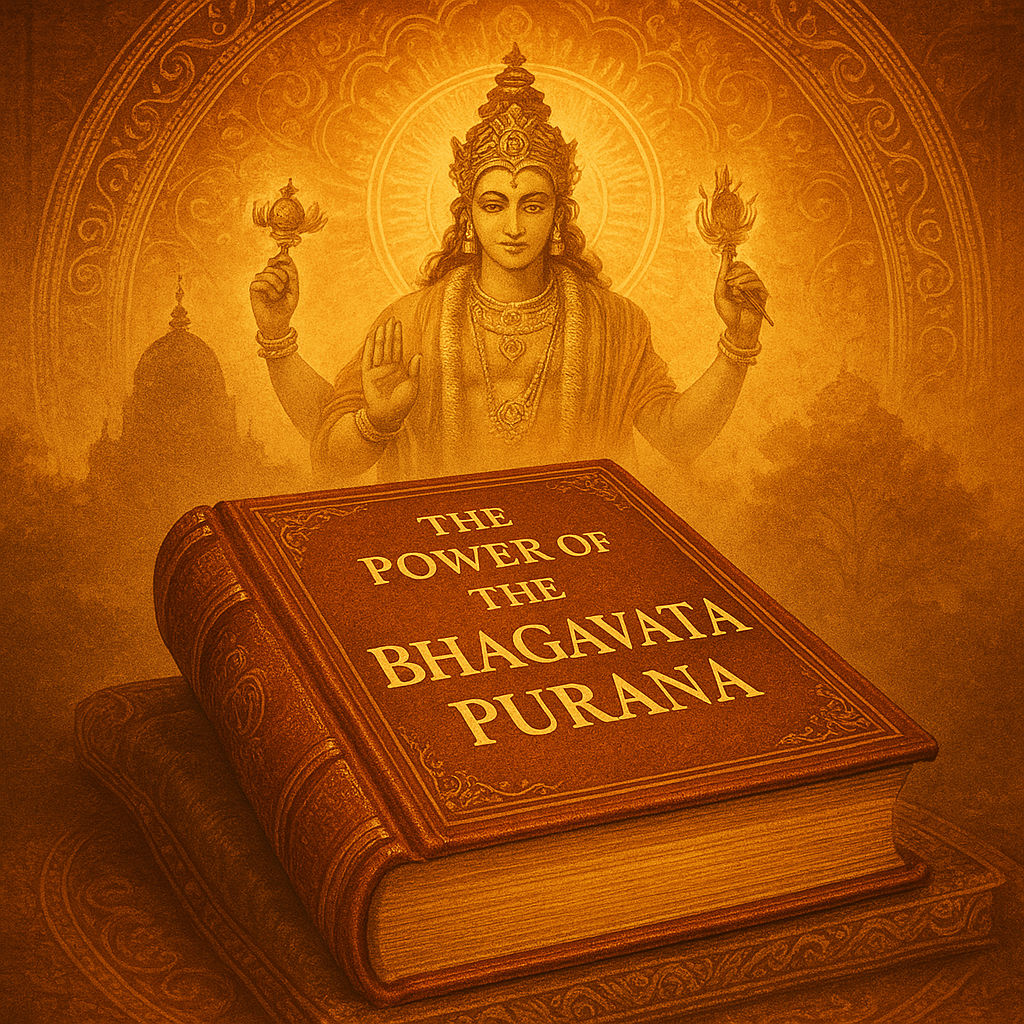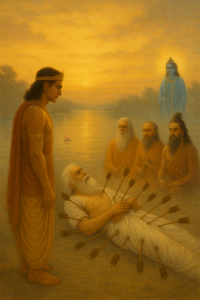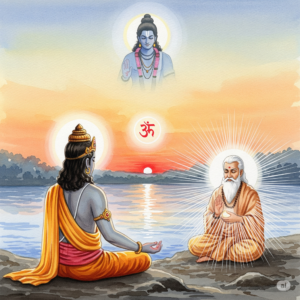The Bhagwat Purana is more than a scripture—it is a beacon of hope, wisdom, and spiritual awakening. Its timeless stories, woven with emotion, ethical dilemmas, and pathways to self-discovery, resonate deeply across ages. Let us delve into two of its profound tales: Bhakti’s Journey of Revival and Gaukarna’s Path to Liberation, understanding how they transcend their ancient origins to illuminate modern life.
Bhakti’s Story: A Mother’s Cry for Revival
At the very start of Kali Yuga, Narad Muni, the celestial sage, travelled across the sacred land of Bharat. His pilgrimage to tirthas like Pushkar, Kashi, Prayagraj, and Haridwar left him disturbed—dharma seemed to be eroding. Satya (truth), daya (compassion), tapa (austerity), and daan (charity) were vanishing under the veil of materialism. Seeking solace, he arrived at the banks of Yamunaji, in Vrindavan, where the echoes of Shri Krishna’s pastimes were still palpable.
On arrival, a heart-wrenching scene unfolded before him. A radiant young woman sat weeping beside two frail and unconscious men. Around her, other divine women, personifications of sacred rivers like Ganga and Saraswati, tried to console her. Struck by her despair, Naradji approached the woman and inquired about her plight.
The woman introduced herself as Bhakti, the very embodiment of devotion. Pointing to the two men, she explained, “They are my sons, Gyan (knowledge) and Vairagya (detachment). We have traversed the epochs of Satya, Treta, and Dwapar Yugas in harmony. But with the advent of Kali Yuga, they began to age and weaken. We sought refuge at Yamunaji’s banks, but though I was rejuvenated, my sons remain lifeless. It breaks my heart—a mother should not outlive her children.”
Naradji listened intently as Bhakti shared her sorrow and her anguish at Raja Parikshit allowing Kali to reside on Earth. Why hadn’t he banished it entirely?
Naradji consoled her, explaining, “Kali Yuga, despite its vices, has a unique quality—moksha (liberation) can be attained by simply taking the name of Shri Hari (Krishna). Bhakti, dear to Krishna Himself, sustains bhaktas (devotees), but Kali’s influence has drained the strength of Gyan and Vairagya. Their revival lies in an act of profound spiritual merit.”
The Divine Remedy
Naradji tried reciting Vedas and Upanishads to the unconscious sons, but they stirred only slightly before falling back into oblivion. At this moment, a divine voice (Akashvani) advised Narad to undertake a specific good deed to restore Bhakti and her sons to full vitality. Puzzled, Naradji consulted sages across the land, seeking clarity.
Eventually, Naradji met the Sankadi Rishis, the ancient sons of Brahma, who reside in Vaikuntha. They explained that Gyan and Vairagya could be revitalized through the recitation of the Bhagwat Purana, the essence of all Vedic scriptures and the eternal home of Shri Krishna. Inspired, Naradji organized a grand yajna (ceremony) to recite the Bhagwat Purana, choosing Anand at the banks of Haridwar for this auspicious event as advised by Sankadi Rishis.
As the verses of the Bhagwat flowed, a miraculous transformation unfolded. Bhakti glowed with divine beauty, clad in the meanings of the shlokas as ornaments. Her sons, Gyan and Vairagya, regained their youthful energy, dancing and singing Shree Krishna’s praises. Shree Krishna Himself blessed the gathering with His spiritual presence, and Naradji rejoiced in fulfilling his promise.
Closing Thought
Consider Bhakti as the modern human heart, torn between spirituality and materialism, with Gyan and Vairagya as dormant values awaiting revival through meaningful engagement with spiritual practices. Bhakti’s story reminds us of the eternal connection between devotion, knowledge, and detachment, even in an era rife with distractions. The story urges us to turn to wisdom and spirituality for rejuvenation, even amidst modern struggles.
Bhakti teaches us that devotion, combined with conscious learning and detachment from negative influences, can help overcome life’s chaos, making spiritual growth attainable even amidst modern complexities
Gaukarna Katha: The Saga of Karma, Redemption, and Divine Intervention
The Despair of Atmadev
Once, in a village by the Tungabhadra River, there lived a Brahmin named Atmadev, a man of great devotion but plagued by a deep sorrow—he was childless. Despite his wealth, intelligence, and virtuous nature, the absence of progeny haunted him. This despair consumed him, as he feared that his lineage would end with him, and there would be no one to perform his shraaddha rites (rituals for the deceased).
Unable to bear this grief, Atmadev wandered into the forest to contemplate his fate. There he encountered a wise sage. Falling at the sage’s feet, he tearfully shared his plight. The sage, known for his ability to read the destiny of others, calmly advised, “O Atmadev, your destiny is fixed; you are not fated to have a child. It would be wise to accept this as the will of the divine.”
Atmadev, unwilling to resign to his fate, implored the sage for a solution. Moved by his persistent pleading, the sage relented and gave him a magical fruit, saying, “If your wife eats this fruit with discipline and devotion, she will give birth to a child. However, she must uphold vows of self-restraint, such as avoiding deceit, anger, and excess.”
The Birth of Dhundhukari and Gaukarna
Atmadev’s wife, Dhundhuli, was cunning and lazy, a woman who loved comfort more than virtue. Fearing the hardships of pregnancy and childbirth, she schemed a plan with her pregnant sister. She decided that her sister would give her the baby after birth, allowing Dhundhuli to avoid eating the fruit altogether.
Unbeknownst to her husband, Dhundhuli fed the fruit to their household cow. Months passed, and as her plan unfolded, Dhundhuli presented a newborn as her own, naming the child Dhundhukari. To the amazement of everyone, the cow that had eaten the fruit gave birth to a miraculous child—a boy with cow-like ears—whom they named Gaukarna (‘Go’ meaning cow and ‘karna’ meaning ears).
From the beginning, the two children were vastly different. Dhundhukari grew into a violent, greedy, and sinful boy, while Gaukarna exhibited signs of wisdom and spirituality. He had an unshakable devotion to the divine and sought solace in the scriptures.
Dhundhukari’s Downfall
As Dhundhukari grew, his sinful nature became evident. He engaged in theft, deceit, and even violence. Unmindful of morality, he squandered wealth, often bringing shame to his family. In stark contrast, Gaukarna renounced material pleasures and chose to live a life of renunciation, dedicating himself to spiritual pursuits.
Eventually, Dhundhukari’s sins reached a peak. In his insatiable greed, he subjected his parents to unspeakable cruelty, demanding more wealth to sustain his debauchery. Unable to bear their plight, Dhundhuli took her own life, while Atmadev renounced the household to become a wandering ascetic.
Free from his parents’ oversight, Dhundhukari descended deeper into depravity. His house became a den of vice, and he indulged in unspeakable crimes. Finally, his karma caught up with him: the women he had wronged killed him in his sleep, leaving his soul to wander as a preta (restless ghost), cursed by his accumulated sins.
The Ghost of Dhundhukari
Years later, Gaukarna returned to his ancestral home after completing his pilgrimage. He found it abandoned; its once-vibrant aura now shadowed by despair. In his meditation, Gaukarna sensed the lingering presence of a tormented spirit. When he called out for his brother, Dhundhukari’s ghost appeared, emaciated and bound by the weight of his karma.
Weeping, the ghost narrated his tale. “O Gaukarna, my sins have left me trapped in this preta form. I wander without peace, tormented by my actions. Save me, my brother, for you are the only one who can redeem me!” Touched by his brother’s plight, Gaukarna vowed to liberate Dhundhukari from his cursed existence.
The Path to Liberation
After intense prayer and meditation to Surya Dev, Gaukarna received a divine revelation: the Bhagwat Purana was the only means to grant liberation to his brother’s tormented soul. Inspired by this revelation, Gaukarna organized a grand recitation of the Bhagwat at their village. Many sages, villagers, and divine beings came to participate in this sacred event.
At that moment, Dhundhukari’s ghost arrived at the scene, seeking a suitable place to sit and listen to the Bhagwat. After glancing around, its eyes fell upon a cluster of upright bamboo stalks, each with seven distinct knots. Spotting an opportunity, the ghost, which existed in the form of air, entered the hollow of one of the bamboo stalks. Being incorporeal, it couldn’t sit out in the open, so it found refuge within the bamboo to quietly listen to the tale being told.
Breaking the Knots of Karma
The recitation lasted seven days. With each passing day, one knot of the bamboo broke, symbolizing the gradual liberation of Dhundhukari’s spirit. Each chapter of the Bhagwat unraveled the karmic bonds that held him captive. The narrative of Shri Krishna’s divine exploits, the cosmic truths, and the essence of devotion brought immense transformation to Dhundhukari’s soul.
On the seventh day, as the final knot burst, a radiant Dhundhukari emerged from the bamboo, freed from his ghostly form. Clad in divine light and free of all burdens, Dhundhukari was lifted into the skies. Shri Krishna’s celestial chariot descended, carrying him to Vaikuntha (the eternal abode of Vishnu). Dhundhukari bowed deeply to Gaukarna and departed, filled with gratitude.
Lessons from the Audience
While the audience witnessed this divine event, they wondered why they themselves had not achieved such liberation despite participating in the recitation. The divine beings revealed the reason: Dhundhukari alone had listened with unwavering devotion, complete surrender, and a burning desire for liberation.
This lesson underlines the shraddha (faith) required for true transformation—engagement with the divine must be wholehearted and sincere for its fruits to manifest.
The Legacy of Gaukarna
After the liberation of Dhundhukari, Gaukarna continued his spiritual journey, spreading the message of devotion and the power of the Bhagwat Purana. His story serves as a beacon of hope: even the most heinous sinner can find redemption through sincere effort, faith, and divine grace.
Modern Analogy: In today’s terms, think of Dhundhukari as someone burdened by past mistakes, seeking redemption through therapy, mindfulness, or faith. Gaukarna’s recitation represents the therapeutic process that heals layer by layer, symbolized by the breaking knots. While passive consumption of spiritual or motivational content might not suffice, deep engagement, reflection, and application of wisdom lead to genuine change.
Key Messages and Modern Relevance
The story of Gaukarna teaches us:
- The Burden of Karma: Every action leaves an imprint on the soul. Gaukarna’s story reminds us to live a life of righteousness to avoid being ensnared by the consequences of our actions.
- Redemption through Devotion: No sin is too great for redemption when there is sincere effort and devotion to the divine.
- Listening with Sincerity: Engaging fully with spiritual teachings is vital. Like Dhundhukari, we must listen with an open heart and undivided focus to attain lasting transformation.
- The Power of Spiritual Practices: Rituals like the Bhagwat recitation and stories of the divine have the power to transform not just individuals but their entire karmic path.
This narrative reflects that even in our modern lives, weighed down by distractions and karmic entanglements, salvation lies in sincere devotion, unwavering faith, and embracing the transformative power of wisdom.
Conclusion: Awakening to Timeless Wisdom
The grandeur of the Bhagavad Purana lies not only in its vivid narratives but also in its ability to illuminate paths to spiritual awakening, even in the darkest times. By invoking stories that reflect ethical dilemmas, universal emotions, and the transformative power of devotion and knowledge, it serves as a guidebook for life’s profound journey.
The stories of Bhakti and Gaukarna underscore the transformative power of faith, the importance of devotion, and the spiritual awakening achievable in Kali Yuga. They encourage us to shift from self-centered pursuits to surrendering to the divine, reminding us that even amidst chaos, spiritual truths remain timeless.
As Bhakti rejuvenates through the recitation of sacred wisdom, and Dhundhukari transcends ignorance through engaged listening, these tales remind us that spiritual truths are timeless. By embracing such teachings, we too can navigate life’s trials, finding solace, clarity, and connection to a higher purpose.
This rich tapestry of stories inspires hope: If Bhakti, Gyan, and Vairagya can rejuvenate, and a restless soul like Dhundhukari can find peace, then so can we, amid our challenges



